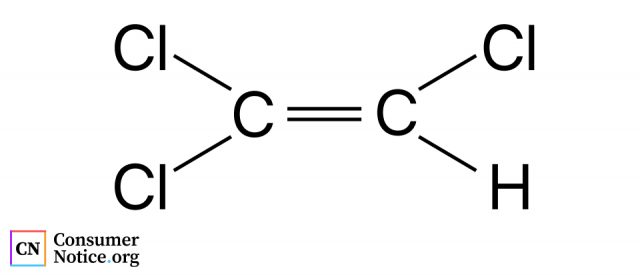Trichloroethylene
Trichloroethylene, or TCE, is an industrial solvent that is also found in certain household cleaning products. It is known to cause kidney cancer, liver damage and harm to unborn children. Exposure primarily occurs in occupational settings, and may also occur through contaminated groundwater.

What Is Trichloroethylene?

Trichloroethylene, commonly referred to as TCE, is a nonflammable, colorless liquid that is primarily used to degrease metal parts. This synthetic solvent is found in certain consumer products including adhesives, wood finishes, paint remover and stain remover.
Trichloroethylene does not occur naturally and is made in laboratories. It is denser than water and has a sweet, chloroform-like odor. In addition to its use as an industrial solvent, trichloroethylene is used in the production of refrigerants.
Why Is TCE Dangerous?
Trichloroethylene is dangerous because it is known to cause kidney cancer. Some research suggests it may also be associated with an increased risk of non-Hodgkin lymphoma and liver cancer.
Strong evidence shows TCE is toxic to the kidney, liver, central nervous system, immune system, male reproductive system and unborn children. Suggestive evidence shows it may be toxic to the respiratory tract and female reproductive system.
TCE Exposure Side Effects
Side effects of exposure to trichloroethylene may affect the respiratory system, central nervous system, vision, hearing, cognition and coordination. TCE exposure may cause skin reactions, headaches, nausea and dizziness. Inhalation of trichloroethylene at high concentrations can affect the heart, liver and kidneys, and it may lead to confusion, sleepiness, unconsciousness and even death by causing an abnormal heart rate (arrhythmia).
Short exposures tend to result in headaches, nausea and incoordination. Long-term exposure is associated with central nervous system depression, kidney failure and increased cardiac (heart) output.
TCE exposure is a risk factor for developing a form of pulmonary hypertension known as pulmonary veno-occlusive disease. The disease is characterized by the blockage of blood vessels that carry oxygen from the lungs to the heart. Lung transplantation is the preferred treatment for patients who qualify.
Research shows long-term occupational exposure to TCE may lead to striatonigral degeneration, which is a neurological disorder that causes symptoms resembling some of those seen in Parkinson’s disease. These symptoms include rigidity, instability, impaired speech and slow movements.
Skin contact with trichloroethylene liquid or vapors can cause rough, dry and red skin that leads to secondary infection. A 2020 study published in a Chinese journal investigated patients with a form of dermatitis that developed after TCE exposure and found it was associated with immune dysfunction and possibly liver injury.
In the 1960s, adolescents were inhaling TCE-containing products, such as Carbona brand cleaning solvent, to get high. Side effects included euphoria, dizziness, sleepiness, unconsciousness, confusion, memory loss and facial numbness.
How Is Trichloroethylene Used?
TCE is currently used as an industrial solvent, metal degreaser, laundry spot remover and typewriter correction fluid. It can be used to make refrigerants, PVC plastic, pesticides and flame retardants. It is added to adhesives, glue, paint and stain removers, arts and crafts spray coatings and automotive care products including brake cleaners. TCE can also be added to household cleaning products such as cleaning wipes, aerosol cleaning products, tool cleaners, gun cleaners and carpet cleaners.
TCE was formerly used as a caulking substance in shipbuilding, a dying agent in varnishes, a solvent for rubber and insecticides and as an antifoaming agent. It was used in agriculture as a fumigant mixture and as a solvent for processing grains. Every branch of the U.S. armed forces used TCE to degrease equipment, which is why the chemical contaminates soil and groundwater around many military bases.
In 1977, the U.S. Food and Drug Administration banned the use of TCE as an anesthetic and analgesic. In the 1950s and ’60s, TCE was used for anesthesia on women during childbirth. This use started in the 1940s, when it was used medically as an inhalable anesthetic and analgesic in obstetrical and surgical settings and as a treatment for migraines.
TCE was used by the food industry to produce decaffeinated coffee, vegetable oils and spice extracts. This practice ended in the mid-1970s following studies sponsored by the National Cancer Institute that found TCE caused cancer in mice. Trichloroethylene was patented in 1906 originally synthesized in 1864.
How Are People Exposed to TCE?
Exposure to TCE may occur through inhalation, ingestion, drinking water and skin absorption. Trichloroethylene exposure primarily occurs in the workplace, and it may also occur environmentally through exposure to contaminated groundwater, air and soil.
The most common occupational settings for TCE exposure include degreasing operations, electronic cleaning, silk screening, taxidermy, dry cleaning and commercial laundry operations.
Environmental TCE exposure remains a risk to certain communities throughout the U.S. because TCE contamination spreads over time into groundwater wells and aquifers.
Air, Soil and Groundwater Contamination
When trichloroethylene contaminates air, soil or groundwater, the area of contamination is known as a TCE plume. The largest TCE plume in the world is in the small town of Mancelona, Michigan. The plume spans six miles and expands approximately 300 feet a year. An estimated 13 trillion gallons of groundwater in the area are contaminated with TCE. Residents continue to rely on a temporary municipal water system that the state of Michigan established to access safe drinking water.
In July 2021, some residents living in a luxury apartment building in Needham, Massachusetts, were relocated when high levels of trichloroethylene vapor were detected in the air of certain apartments on the north side of the building. The Massachusetts Department of Environmental Protection is investigating the source of the TCE vapor to remediate the issue.
Stories of TCE contamination have made major headlines, and one of them, “A Civil Action,” became a best-selling novel and an Oscar-nominated film of the same name. The book and film focus on the liability lawsuit involving eight families from Woburn, Massachusetts, who sued W.R. Grace, Beatrice Foods and Unifirst Company claiming they dumped chemicals, including TCE, that contaminated the town’s groundwater and caused seven children and one adult to develop leukemia.
Could My Water Be Contaminated with TCE?
In 2019, the Agency for Toxic Substances and Disease Registry reported that between 4.5% and 18% of drinking water supply sources tested annually by the U.S. Environmental Protection Agency contain trichloroethylene, but most municipal water sources remain in compliance with the maximum contaminant level.
Communities near military bases, automotive industries, chemical plants and industrial landfills face greater risk of TCE groundwater contamination.
If you are concerned about TCE contamination, you can have a sample of your drinking water tested by a certified laboratory.
Individuals and communities have filed trichloroethylene lawsuits over contaminated water and resulting health effects. These lawsuits have resulted in compensation for individuals to cover medical costs for TCE-related diseases and compensation for communities to cover groundwater cleanup costs.
Will the EPA Ban Trichloroethylene?
In November 2020, the U.S. Environmental Protection Agency completed a final risk evaluation for trichloroethylene. The agency determined an unreasonable risk currently exists for workers, consumers and bystanders for 52 of the 54 current uses for TCE.
The agency is now developing actions it could take to address these unreasonable risks, which may include regulations to ban or limit the manufacture, distribution, use and disposal of TCE. In 2016, the agency announced it was looking into banning certain uses of TCE, but that initiative was delayed by the Trump Administration.
In May 2020, Minnesota became the first state to ban trichloroethylene. California banned dry cleaning uses of TCE-containing spot removers in 2012, and it prohibited use of TCE in consumer products in 2002.
Studies conducted by the National Cancer Institute in the 1970s found TCE in decaffeinated coffee and spice extracts, which led the U.S. Food and Drug Administration to draft an order to ban TCE in the food industry in 1977.
24 Cited Research Articles
Consumernotice.org adheres to the highest ethical standards for content production and references only credible sources of information, including government reports, interviews with experts, highly regarded nonprofit organizations, peer-reviewed journals, court records and academic organizations. You can learn more about our dedication to relevance, accuracy and transparency by reading our editorial policy.
- Fiandaca, C. (2021, July 8). I-Team: State Investigating Toxic Chemical At Needham Luxury Apartment Building. Retrieved from https://boston.cbslocal.com/2021/07/08/iteam-the-kendrick-needham-apartment-building-toxic-gas-tce/
- PubChem. (2021, July 24). Trichloroethylene. Retrieved from https://pubchem.ncbi.nlm.nih.gov/compound/Trichloroethylene
- National Toxicology Program. (2021, May 26). RoC Review of Trichloroethylene (TCE). Retrieved from https://ntp.niehs.nih.gov/whatwestudy/assessments/cancer/completed/tce/index.html
- U.S. FDA. (2021, May 19). Trichloroethylene. Retrieved from https://www.cfsanappsexternal.fda.gov/scripts/fdcc/index.cfm?set=FoodSubstances&id=TRICHLOROETHYLENE
- Minnesota Department of Health. (2021, May 17). Trichloroethylene (TCE) and Your Health. Retrieved from https://www.health.state.mn.us/communities/environment/hazardous/topics/tce.html
- Deng, L.D. et al. (2020, October 20). Peripheral T and B lymphocytes in patients with occupational medicamentosa-like dermatitis due to trichloroethylene. Retrieved from https://pubmed.ncbi.nlm.nih.gov/33142373/
- Caliez, J. et al. (2020, October 16). Trichloroethylene increases pulmonary endothelial permeability: implication for pulmonary veno-occlusive disease. Retrieved from https://journals.sagepub.com/doi/10.1177/2045894020907884
- National Law Review. (2020, May 20). Minnesota Becomes First State to Ban TCE: Considerations Once a Chemical Is Banned. Retrieved from https://www.natlawreview.com/article/minnesota-becomes-first-state-to-ban-tce-considerations-once-chemical-banned
- U.S. CDC. (2019, June 21). Trichloroethylene. Retrieved from https://www.cdc.gov/niosh/topics/trichloroethylene/default.html
- ATSDR. (2019, June). Toxicological Profile for Trichloroethylene. Retrieved from https://www.atsdr.cdc.gov/ToxProfiles/tp19.pdf
- Rihana-Abdallah, A. and Pang, Y. (2019). Fate and Transport of a TCE Groundwater Contamination Plume. Retrieved from http://people.cst.cmich.edu/yelam1k/asee/proceedings/2019/1/71.pdf
- National Cancer Institute. (2018, December 10). Trichloroethylene (TCE). Retrieved from https://www.cancer.gov/about-cancer/causes-prevention/risk/substances/trichloroethylene
- Tong, S. (2018, July 26). The EPA says TCE causes cancer, so why hasn’t it been banned? Retrieved from https://www.marketplace.org/2018/07/26/epa-says-tce-causes-cancer-so-whys-proposed-ban-been-delayed/
- ATSDR. (2017, February 2). TCE Overview. Retrieved from https://www.atsdr.cdc.gov/tox-tool/trichloroethylene/01/tce_overview.html
- ATSDR. (2013, December 10). Who Is at Risk of Trichloroethylene Exposure? Retrieved from https://www.atsdr.cdc.gov/csem/trichloroethylene/who_is_at_risk.html
- Chiu, W.A. et al. (2012, December). Human Health Effects of Trichloroethylene: Key Findings and Scientific Issues. Retrieved from https://www.ncbi.nlm.nih.gov/pmc/articles/PMC3621199/
- Sliwinska-Kowalska, M. (2011). Trichloroethylene. In Encyclopedia of Environmental Health (Second Edition). Retrieved from https://www.sciencedirect.com/science/article/pii/B9780444639516002552
- U.S. EPA. (2000). Trichloroethylene. Retrieved from https://www.epa.gov/sites/default/files/2016-09/documents/trichloroethylene.pdf
- Easterbrook, G. (1995, September 10). Toxic Business. Retrieved from https://archive.nytimes.com/www.nytimes.com/books/97/12/07/bsp/18426.html
- Colburn, D. (1986, February 26). Decaf: Extracting The Kick. Retrieved from https://www.washingtonpost.com/archive/lifestyle/wellness/1986/02/26/decaf-extracting-the-kick/7c60aad9-2a75-4575-ae2b-c8b5d6dd2b85/
- Waters, E.M., Gerstner, H.B., and Huff, J.E. (1977). Trichloroethylene. I. An overview. Retrieved from https://pubmed.ncbi.nlm.nih.gov/403297/
- Litt, I.F. and Cohen, M.S. (1969). Danger vapor harmful: spot-remover sniffing. Retrieved from https://hero.epa.gov/hero/index.cfm/reference/details/reference_id/75168
- Parkhouse, J. (1965). Trichloroethylene. Retrieved from https://www.sciencedirect.com/science/article/pii/S0007091217535576
- Westlaw. (n.d.). California Code: 94509. Standards for Consumer Products. Retrieved from https://govt.westlaw.com/calregs/Document/I9B76822D2158400C9C5DE2C773DD6E61?viewType=FullText&originationContext=documenttoc&transitionType=CategoryPageItem&contextData=(sc.Default)
Calling this number connects you with a Consumer Notice, LLC representative. We will direct you to one of our trusted legal partners for a free case review.
Consumer Notice, LLC's trusted legal partners support the organization's mission to keep people safe from dangerous drugs and medical devices. For more information, visit our partners page.
844-526-0648
